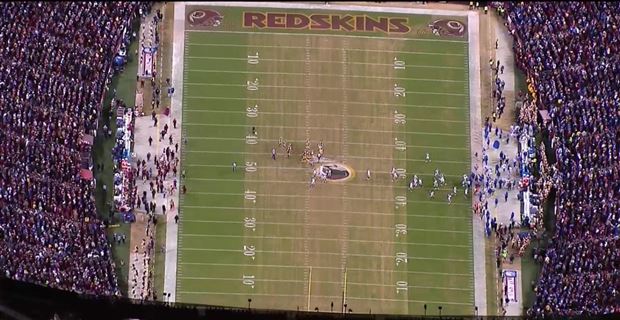Grass Vs. Turf: What do the NFL’s Best Teams Play On?
BY JACKIE GREENE | SEPTEMBER 8TH, 2018 | LAWN CAREIn a 2017 Washington Redskins season filled with the team’s typical humiliations — being swept by their rival Dallas Cowboys, blowing a 15-point lead to New Orleans with less than three minutes left in the game — one of the NFL’s most moribund franchises added a new point of disgrace: players blasting the condition of their home stadium’s grass.
“It probably doesn’t look like a professional NFL field should,” said Redskins quarterback Kirk Cousins after he spent a Thanksgiving game slipping all over FedEx Field shoddy-looking Latitude 36 Bermuda Grass.

FedEx Field during the Thanksgiving game (courtesy of 247 Sports)
With the resignation of a World War 1 soldier going over the top, Cousins indicated the problem would only get worse as the season went on.
“If you think the field is rough now on Thanksgiving, we’ve got two more home games in mid-to-late December, and that’s probably gonna be a bigger challenge,” he warned on 106.7 The Fan’s “Grant and Danny” program.
Former Redskins players echoed Cousins’ comments on social media, calling for a switch to artificial turf.
For long-suffering Redskins fans, “TurfGate” became yet another reason why the team has floundered under owner, Dan Snyder. Changing the playing surface, some argued, might help restore the franchise to its former glory.
An hour up I-95, the Baltimore Ravens have a very different perspective. In 2016, the team ditched the synthetic turf it had used for 13 years in favor of natural Tifway 419 Bermuda Grass – and the players couldn’t be happier.
“That grass was phenomenal,” fullback Kyle Juszczyk told baltimoreravens.com. “I’m very pro-grass. My knees feel better after practice, and there was good traction all night.”
“I love the field,” running back Terrance West agreed. “It makes the cuts easier and I like it.”
Field conditions across the NFL will always vary due to climate and human logistics, so it’s natural that players may have different perspectives on what surface type best sets them up for success. But what does the data say?
We calculated the winning percentage from each team over the last 10 seasons, including the current one, and divided them into two categories based on their home stadium: natural grass and artificial turf.
Hybrid systems like GrassMaster that use real grass reinforced with artificial fibres are included in the natural grass category. An example of this type of playing surface can be found at the Green Bay Packers’ famed Lambeau Field.
For teams like the Ravens that switched playing surfaces during the 10-year period, we counted each playing surface as a separate team. And ties are considered losses because this is football, dang it, not soccer.
Which surface reigns supreme in recent history? With a winning percentage of .525, teams that play their home games on artificial turf handily beat their natural grass counterparts, who have a combined winning percentage of .474.
Top Five Teams (Natural Grass)
1. Steelers (.662 winning percentage)
2. Packers (.625)
3. Broncos (.575)
4. Eagles (.556)
5. Panthers/Cardinals (.537)
Top Five Teams (Artificial Turf)
1. Patriots (.768)
2. Ravens, 2008-2015 (.601)
3. Saints/Falcons (.593)
4. Colts (.568)
5. Seahawks/Cowboys (.550)
It’s no surprise that the Patriots stand head and shoulders above the rest, even after they had to replace their synthetic turf this season after player complaints. Their absurd .768 winning percentage single handedly raised the combined turf teams’ combined average up nearly two points.
On the flip side, the Browns’ debacle of a decade not only earned them last place with a truly wretched .237 winning percentage, but dragged the entire winning percentage of the natural grass teams down two points.
Removing those two outliers and you have a more even matchup: .507 for teams with natural grass home fields versus .491 for teams playing on artificial turf.
Worst Five Teams (Natural Grass)
Browns (.237 winning percentage)
Jaguars (.325)
Buccaneers (.368)
Raiders (.387)
Redskins (.400)
Worst Five Teams (Artificial Turf)
1. Rams, 2008-2015 (.304)
2. Lions (.406)
3. Bills (.425)
4. Jets (.468)
5. Texans (.487)
The data also doesn’t always tell the full story. For examples, the Steelers have often succeeded in spite of their frequently criticized field, most infamous for the “mud punt.”
And players come down strongly in favor of natural grass. An NFL Players Association poll taken in 2010 showed that 89.7% said artificial turf is more likely to shorten their career, 89.1% said they are more sore after playing on that synthetic surface, and 82.4% said fake grass is more likely to contribute to an injury. However, players also voted the frequently muddy grass in Pittsburgh’s Heinz Field the worst in the NFL.
Of the four teams remaining in this year’s NFL playoffs, the Eagles and Jaguars play on natural grass (GrassMaster hybrid surface and Tifway 419 Bermuda Grass, respectively) while the Patriots and Vikings use turf to maintain playing conditions throughout their cold winters (FieldTurf and UBU Speed Series S5-M).
Home Field of the Last 10 Super Bowl Winners
2017: ?
2016: Turf (Patriots)
2015: Grass (Broncos)
2014: Turf (Patriots)
2013: Turf (Seahawks)
2012: Turf (Ravens)
2011: Turf (Giants)
2010: Grass (Packers)
2009: Turf (Saints)
2008: Grass (Steelers)
It’s been a rough decade for teams that use natural grass, and it’s not certain to get better soon – this year’s betting line is predictably skewed toward the turf duo, with Tom Brady the odds-on favorite to bring a sixth ring back to New England.
Updated #SBLII futures:
Patriots +120
Vikings +175
Eagles +700
Jaguars +800Via BetOnline @DaveMasonBOL
— OddsShark (@OddsShark) January 15, 2018
But after a Divisional Playoff weekend that saw the Minneapolis Miracle and Blake Bortles outshining Ben Roethlisberger, it’s clear that anything can happen.
Data Sources:
https://www.pro-football-reference.com
https://www.lawnstarter.com/blog/sports-turf/nfl-stadiums-turf-or-grass/
https://www.si.com/nfl/2015/10/01/nfl-stadium-turf-grass-rankings
https://turfprossolution.com/which-nfl-stadiums-have-artificial-turf/
http://www.latimes.com/sports/nfl/la-sp-nfl-ask-farmer-20171111-story.html